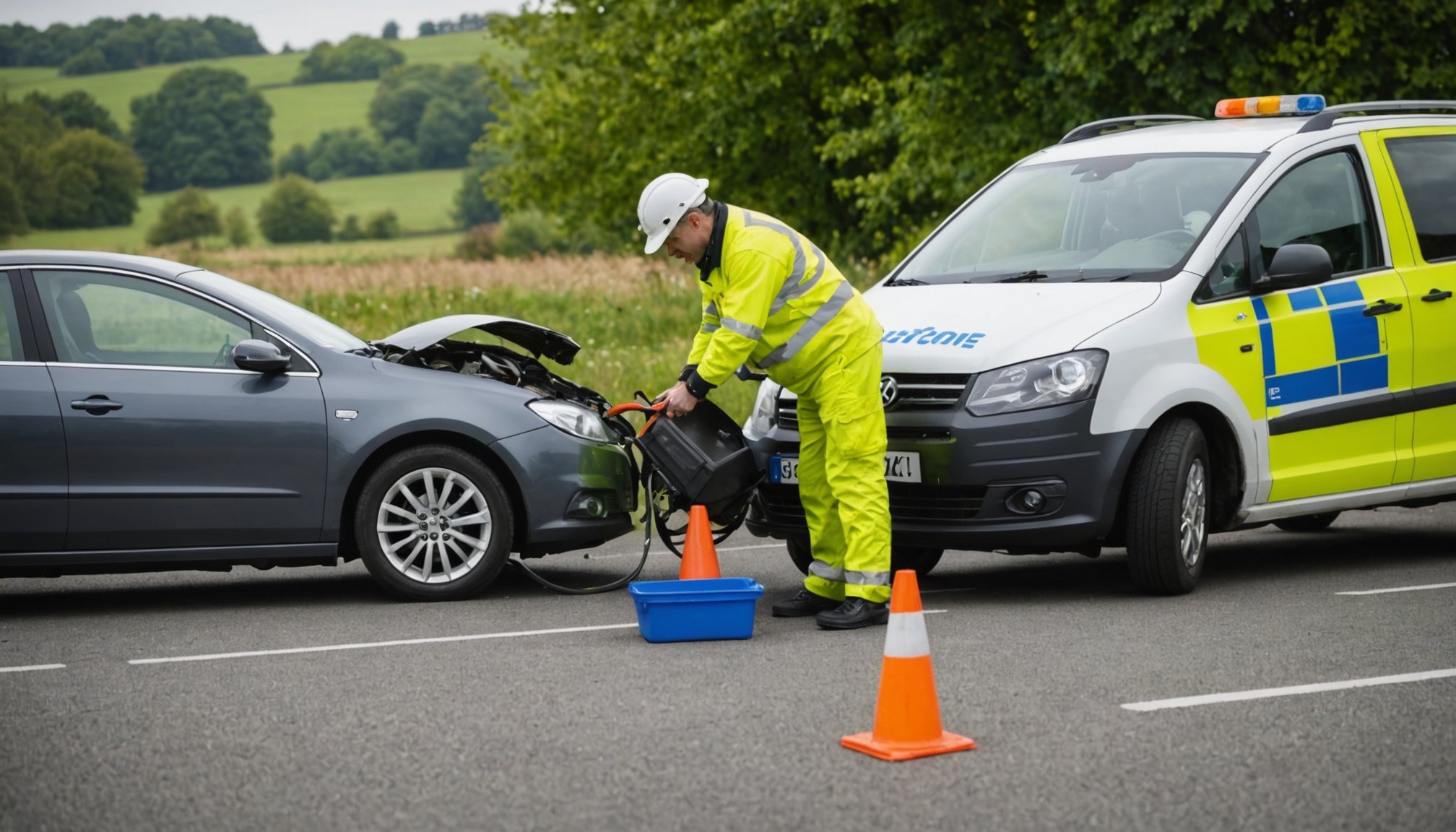Overview of Roadside Assistance Plans
Roadside assistance plans are essential safety nets, providing vehicle support when unexpected breakdowns occur. These UK roadside services offer peace of mind, knowing help is just a phone call away. Plans typically include basic add-ons and services tailored for diverse needs, ensuring drivers are equipped to handle the unforeseen.
Types of Roadside Assistance Plans:
- Local Plans: Focus on nearby service areas, ideal for city drivers who rarely venture out of town.
- National Plans: Best for those who travel across the UK, offering extensive coverage miles beyond home.
Common Services:
Roadside assistance plans usually include vital services:
Also read : Essential guide to knowing when your vehicle needs professional alignment services in the uk
- Towing: Moving your vehicle to a repair shop safely.
- Fuel Delivery: Preventing delays if you run out of fuel.
- Lockout Services: Gaining access to your vehicle if you’re locked out.
In the UK, roadside assistance is indispensable for any vehicle owner. With a variety of plans available, it’s crucial to select one that aligns with your driving habits and needs. Considering factors like coverage area and common services ensures you receive optimal protection when needed.
Factors to Consider When Choosing a Plan
When choosing roadside assistance, evaluating coverage options and comparing costs are crucial steps. Coverage areas range widely, with local services suiting drivers who often remain in-town, while national providers benefit those covering longer distances across the UK. Carefully assess the scope of coverage offered by each plan to ensure it meets your specific travel patterns.
Also to read : Unlocking the secrets of uk company car fleet management: your ultimate guide to logistics success
Another vital aspect is the cost comparison. Price variations exist across different providers and plans, and evaluating these can lead to potential savings. Examine both the base price and optional add-ons to understand the complete cost structure.
The types of services included in a plan also heavily influence the choice. Consider plans that cover towing, fuel delivery, and lockout services to maximize preparedness for various roadside emergencies. Reviewing the details of these services helps determine which plan offers the most comprehensive assistance for the price.
By focusing on the unique aspects of your driving habits and comparing these factors, you can effectively choose a plan that offers both value and peace of mind.
Comparing Major Roadside Assistance Providers
Selecting the right roadside assistance providers can be daunting given the numerous options available in the UK. Each provider offers unique plans that cater to different needs, with varying features and benefits. A comprehensive service comparison focuses on understanding these distinctions.
Provider A: Overview and Offerings
Provider A prides itself on its robust service comparison, offering extensive coverage across the UK. Key features include comprehensive towing services and emergency fuel delivery. Optional add-ons may include enhanced lockout services and a priority rescue package.
Provider B: Overview and Offerings
Known for competitive pricing, Provider B offers appealing vehicle support for budget-conscious drivers. Their basic package includes essential roadside assistance with the option for additional services like tyre replacements and battery jump-starts, highlighting flexible pricing structures.
Provider C: Overview and Offerings
Provider C emphasises customer satisfaction with diverse coverage options. With flexible plans, it boasts high customer ratings particularly for its nationwide coverage and accessibility. Customers appreciate the round-the-clock support and rapid response times, making it a popular choice among UK providers.
Pros and Cons of Roadside Assistance Plans
Understanding the roadside plan advantages and limitations is crucial before making a commitment. One of the primary benefits includes ensuring vehicle support during unexpected breakdowns, offering peace of mind. Plans often incorporate essential services such as towing and fuel delivery, which can save both time and money when mishaps occur.
However, there are potential disadvantages to be aware of. Some plans may come with hidden costs or limited coverage, restricting assistance to certain geographical areas. It’s vital to closely review terms and conditions to avoid surprises. User feedback often highlights concerns about long response times and inadequate service quality, particularly with budget plans.
Moreover, testimonials reveal that while some enjoy the security of UK roadside services, others feel their usage frequency does not justify the expense. Individuals with reliable vehicles or minimal travel needs may find fewer benefits. Balancing these pros and cons by assessing personal driving habits can aid in selecting a plan that truly aligns with one’s lifestyle.
Step-by-Step Guide to Selecting the Best Plan
Choosing the right roadside assistance plan requires a methodical approach to ensure it aligns with individual needs. The initial step involves evaluating your driving habits. Consider factors such as the frequency of travel, typical distances covered, and whether your routes are primarily urban or rural. This assessment helps narrow down whether a local or national plan is most suitable.
Once your needs are defined, research and shortlist plans based on coverage options and services like towing and lockout assistance. Comparing features of these plans is crucial; focus on the types of services each offers and their value to your driving routine.
After assembling a shortlist, conduct a cost analysis by comparing the pricing structures of different providers. Examine both base costs and add-ons to determine options that offer the best value without stretching your budget.
Finally, weigh the pros and cons of each plan considering user reviews and personal priorities. By integrating an analytical approach with personalisation, you lay a solid foundation for making an informed decision that boosts both security and assurance on the road.
FAQs about Roadside Assistance
When contemplating roadside assistance FAQs, common inquiries revolve around coverage, costs, and what services plans encompass. “What should my plan cover?” Generally, essential services like towing, fuel delivery, and lockout assistance are crucial. These services ensure you’re not stranded and can address minor emergencies effectively.
“How much will it cost?” Prices vary by provider, influenced by factors like coverage, plan type, and additional options. Typically, plans can start from modest monthly fees, escalating with extra services.
“What if I only drive occasionally?” Even infrequent drivers benefit from basic roadside assistance. Cover remains vital as emergencies are unpredictable.
Misconceptions also arise around service areas. Always verify if local or national coverage is provided. A national plan might be more suitable if long journeys are frequent, whereas local plans favour urban drivers.
For further clarity, consulting reviews from existing customers can offer insights into a provider’s reliability and service quality. Exploring detailed service comparisons aids in making informed choices tailored to specific driving habits.
Reputable Providers and Further Exploration
Navigating the sea of roadside assistance providers in the UK can be challenging. However, several recommended providers stand out due to their reliability and service quality. Offering a broad range of options, these companies cater to various driving needs and preferences.
Highly Rated Providers
- The AA: Known for their comprehensive coverage and quick response times, ensuring vehicle support anytime and anywhere.
- RAC: Offers extensive UK roadside services, praised for their expertise and inclusive plans.
- Green Flag: Recognised for affordable pricing alongside reputable service quality.
Exploring these providers involves digging deeper into their offerings. Consider examining features like network reach, service terms, and real customer reviews on online platforms. Utilize user feedback to weigh the pros and cons effectively, aligning them with personal driving priorities.
Further Reading
For an informed decision, engage with online comparisons and reader reviews. These resources provide transparency regarding pricing structures, coverage details, and customer satisfaction levels. While examining the recommended providers, remember: user experiences are invaluable for gauging a company’s consistency and reliability in real-world scenarios.











